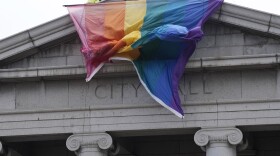Figuring out how old a bone is starts with a saw that looks like an electric toothbrush.
Larkin Chapman, who’s about to start her doctorate in archaeology at the University of New Mexico, is in an office filled with animal bone samples and reference books. She's using a Dermel saw to remove the tip of an ancient horse's foot bone.
As bone dust filled the air, so did a burning smell.
“That smell, it’s burning organic material, and so when you’re doing this sort of sampling you actually want to smell that,” said Chapman. “If you don’t smell that, it’s really likely that you’re just cutting through rock.”
That sample will go to a lab for radiocarbon dating.
A similar process was used to date the remains of a horse at a Puebloan ancestral village in north-central New Mexico. Those remains were part of a study looking at the spread of horses in Indigenous societies across the West.

For centuries, mainstream Western science believed domestic horses first became a part of Indigenous cultures after the 1680 Pueblo Revolt. The Spanish were pushed out of territory that is now New Mexico, and their horses were left behind.
But this story was often based on anti-Indigenous documents.
“Historical documents written down by European folks right in the throes of early colonization,” William Taylor, an assistant professor of archaeology at the University of Colorado Boulder, said.
Taylor is also the lead author on the study published in Science last spring.
He says earlier researchers did not give much weight to Indigenous oral histories that suggest the spread of horses happened earlier.
So he, along with dozens of other scientists and Indigenous cultural experts, used archaeological horse remains and the oral histories to fact-check that Eurocentric narrative.
“There’s compelling evidence for domestic horses being in Indigenous societies, in some cases well before the Pueblo Revolt,” he said.
The remains they sampled were from southwest Wyoming, the American Falls Reservoir in Idaho, New Mexico and Kansas. And that new evidence, Taylor said, matches some Indigenous oral histories.
“We kinda have to ask ourselves, why do we privilege written work over oral work? And who does it benefit?” Kelsey Dayle John, a professor at the University of Arizona, said.
As a Diné scholar, she studies the decolonization of education.
“There is scientific knowledge embedded in oral histories,” John said. “Stories are powerful. And I would say that’s another reason why Indigenous communities are protective over their stories.”
The study doesn’t share these Indigenous stories for this reason.
Yvette Running Horse Collin, head of the Taku Škaŋ Škaŋ Wasakliyapi Global Institute for Traditional Sciences, said they guard Lakota knowledge and guide how it can be shared.
“My people, as well as other Indigenous peoples, have utilized their fortitude and their strength to preserve their traditional and scientific knowledge under incredible duress,” Running Horse Collin, a citizen of the Oglala Sioux Tribe and an author of the study in Science, said.
In the boarding school era, Native children were taken by the federal government to be assimilated into Euro-American society. Students were punished if they did anything connected to their culture – like speaking their Native language.
“And as the war against Native ways and Native culture escalated in the Americas, our knowledge keepers understood that to protect the children, the knowledge had to go underground.” she said.
So tribal teachings were kept from many Lakota children – for their own protection.
But Running Horse Collin said “thankfully,” that knowledge is now being passed on—and, when appropriate, shared with trusted partners.
A couple of years ago, the Biden Administration committed to elevating Indigenous knowledge in federal policy-making. Last year, the administration outlined how it would help make that happen. It promised to help agencies build relationships with tribes and learn how to apply this knowledge to policies, research, management and decision-making.
For Running Horse Collin, it’ll be successful if the Indigenous and mainstream systems work together to create a new framework that includes Indigenous science.
This story was produced by the Mountain West News Bureau, a collaboration between Wyoming Public Media, Nevada Public Radio, Boise State Public Radio in Idaho, KUNR in Nevada, the O'Connor Center for the Rocky Mountain West in Montana, KUNC in Colorado, KUNM in New Mexico, with support from affiliate stations across the region. Funding for the Mountain West News Bureau is provided in part by the Corporation for Public Broadcasting.
Copyright 2023 KUNM. To see more, visit KUNM.






